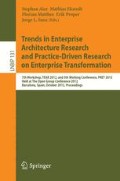Abstract
With the development of Enterprise Architecture (EA) as a discipline, measuring and understanding its value for business and IT has become relevant. In this paper a framework for categorizing the benefits of EA, the Enterprise Architecture Value Framework (EAVF), is presented and based on this framework, a measurability maturity scale is introduced.
In the EAVF the value aspects of EA are expressed using the four perspectives of the Balanced Scorecard with regard to the development of these aspects over time, defining sixteen key areas in which EA may provide value. In its current form the framework can support architects and researchers in describing and categorizing the benefits of EA.
As part of our ongoing research on the value of EA, two pilots using the framework have been carried out at large financial institutions. These pilots illustrate how to use the EAVF as a tool in measuring the benefits of EA.
Access this chapter
Tax calculation will be finalised at checkout
Purchases are for personal use only
Preview
Unable to display preview. Download preview PDF.
References
Zachman, J.: A Framework for Information Architecture. IBM Systems Journal 26(3) (1987)
Ross, J.W., Weill, P., Robertson, D.C.: Enterprise Architecture As Strategy: Creating a Foundation for Business Execution. Harvard Business School Publishing, Boston (2006)
Johnson, P., Ekstedt, M., Silva, E., Plazaola, L.: Using Enterprise Architecture for CIO Decision-making: on the Importance of Theory. In: Proceedings of the 2nd Annual Conference on Systems Engineering Research, CSER (2004)
IEEE. The IEEE 1471-2000 standard - Architecture Views and Viewpoints. IEEE (2000)
Lange, M., Mendling, J.: An Experts’ Perspective on Enterprise Architecture Goals, Framework Adoption and Benefit Assessment. In: Proceedings of the 15th IEEE International Enterprise Distributed Object Computing Conference Workshops (EDOCW), pp. 304–313 (2011)
Tamm, T., Seddon, P.B., Shanks, G., Reynolds, P.: How Does Enterprise Architecture Add Value to Organizations? Communications of the Association for Information Systems 28, Article 10, 141–168 (2011)
Townsend, S.: The Value of Enterprise Architecture, part 1 – 6. Series start (2011), http://www.sdn.sap.com/irj/scn/weblogs?blog=/pub/wlg/22948
van Steenbergen, M., Brinkkemper, S.: Modeling the contribution of enterprise architecture practice to the achievement of business goals. In: Papadopoulos, G.A., Wojtkowski, W., Wojtkowski, W.G., Wrycza, S., Zupancic, J. (eds.) Information Systems Development: Towards a Service Provision Society. Springer, New York (2008)
Boucharas, V., van Steenbergen, M., Jansen, S., Brinkkemper, S.: The Contribution of Enterprise Architecture to the Achievement of Organizational Goals: Establishing the Enterprise Architecture Benefits Framework.Technical Report UU-CS-2010-014, Utrecht (2010)
Slot, R.: A method for valuing Architecture-Based Business Transformation and Measuring the value of Solutions Architecture. PhD Thesis, Utrecht (2010)
van der Raadt, B.: Enterprise Architecture coming of Age. Increasing the Performance of an Emerging Discipline. PhD Thesis, Amsterdam (2011)
Foorthuis, R., van Steenbergen, M., Mushkudiani, M., Bruls, W., Brinkkemper, S.: On course but not there yet: Enterprise Architecture Conformance and Benefits in Systems Development. In: ICIS 2010 Proceedings. Paper 110 (2010)
Schelp, J., Stutz, M.: A Balanced Scorecard Approach to measure the Value of Enterprise Architecture. Journal of Enterprise Architecture 3(1), 5–12 (2007)
Wideman, M.: Improving PM: Linking Success Criteria to Project Type (2008), http://www.maxwideman.com/papers/improvingpm/intro.html
Hevner, A., March, S., Park, J., Ram, S.: Design Science in Information Systems Research. MIS Quarterly 28(1), 75–105 (2004)
Peffers, K., Tuunanen, T., Rothenberger, M.A., Chatterjee, S.: A Design Science Research Methodology for Information Systems Research. Journal of Management Information Systems 24(3), 45–78 (2008)
Pruijt, L., Slot, R., Plessius, H.: The Enterprise Architecture Realization Index. In: Archivalue, Portfolio Management with Enterprise Architecture, Novay, Enschede, pp. 72–81 (2012)
Bowman, C., Ambrosini, V.: Value Creation Versus Value Capture: Towards a Coherent Definition of Value in Strategy. British Journal of Management 11, 1–15 (2000)
Kaplan, R.S., Norton, D.P.: The balanced scorecard—measures that drive performance. Harvard Business Review, 71–79 (January-February 1992)
Kaplan, R.S., Norton, D.P.: Transforming the balanced scorecard from performance measurement to strategic management. Accounting Horizons, part I, 87–104 (March), Part II, 147–160 (June) (2001)
Norreklit, H.: The balance on the balanced scorecard - a critical analysis of some of its assumptions. Management Accounting Research 11, 65–88 (2000)
TOGAF. The Open Group Architecture Framework, Version 9.1. TOGAF (2011), http://www3.opengroup.org/
Bryman, A., Bell, E.: Business Research Methods, 2nd edn. Oxford Press Inc., New York (2007)
Plessius, H., Slot, R.: Valuing Enterprise Architecture. In: Archivalue, Portfolio Management with Enterprise Architecture, Novay, Enschede, pp. 94–99 (2012)
Kohlegger, M., Maier, R., Thalmann, S.: Understanding Maturity Models Results of a Structured Content Analysis. In: Proceedings of IKNOW 2009 International Conference on Knowledge Management and Knowledge Technologies, pp. 51–61 (September 2009)
Author information
Authors and Affiliations
Editor information
Editors and Affiliations
Rights and permissions
Copyright information
© 2012 Springer-Verlag Berlin Heidelberg
About this paper
Cite this paper
Plessius, H., Slot, R., Pruijt, L. (2012). On the Categorization and Measurability of Enterprise Architecture Benefits with the Enterprise Architecture Value Framework. In: Aier, S., Ekstedt, M., Matthes, F., Proper, E., Sanz, J.L. (eds) Trends in Enterprise Architecture Research and Practice-Driven Research on Enterprise Transformation. PRET TEAR 2012 2012. Lecture Notes in Business Information Processing, vol 131. Springer, Berlin, Heidelberg. https://doi.org/10.1007/978-3-642-34163-2_5
Download citation
DOI: https://doi.org/10.1007/978-3-642-34163-2_5
Publisher Name: Springer, Berlin, Heidelberg
Print ISBN: 978-3-642-34162-5
Online ISBN: 978-3-642-34163-2
eBook Packages: Computer ScienceComputer Science (R0)

